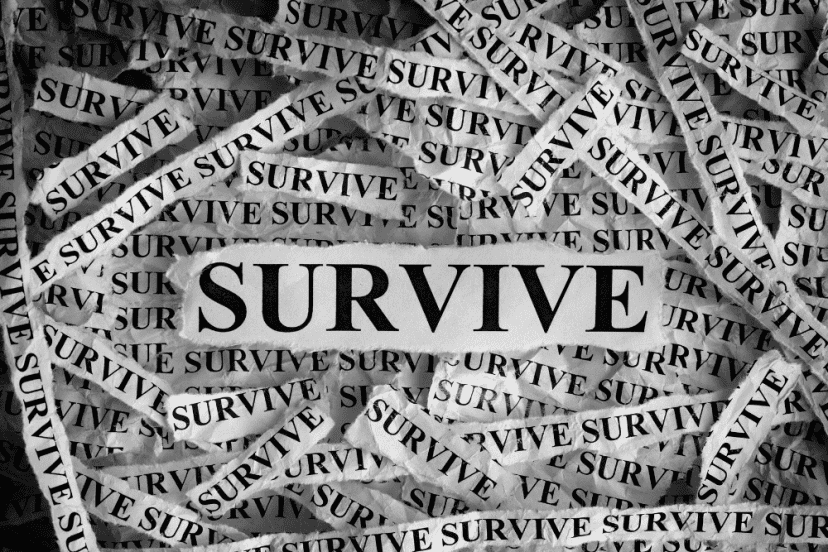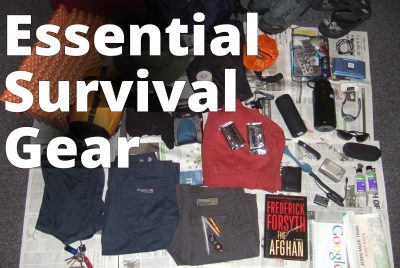Survival Tactics: Essential Strategies for Thriving in Tough Situations
Master Essential Survival Tactics: Your Comprehensive Guide to Thriving in Any Situation
Amidst the untamed wilderness, a lone hiker lost her compass as nightfall descended.
We’re often taught the theoretical. We drill survival techniques and memorize weather patterns as if they were scripture, trusting in this knowledge to shepherd us through nature’s capricious whims.
Yet, it’s the practical application—our ability to adapt and improvise under duress—that transforms theory into a lifesaving balm in the wild.

Assessing the Situation
When immured by the unexpected, the most critical initial step is a comprehensive assessment of your predicament.
This encompasses an analysis of environmental conditions, personal well-being, and available resources—all pivotal factors that dictate the tactical approach to survival.
Recognizing the significance of immediacy without succumbing to precipitous actions is the delicate balance required in these seminal moments.
Understanding the severity and immediacy of your situation will determine the steps to be undertaken with deliberation and precision.
Swiftly identifying both hazards and assets within your vicinity is an indispensable tactic in formulating an effective survival strategy.
Identifying Risks Quickly
Efficient risk assessment is imperative—misjudgment or oversight can exacerbate an already perilous situation.

Danger is not always obvious; a serene environment can mask potential threats, requiring a nuanced understanding of one’s surroundings.
It is crucial to ascertain the nature of potential threats within the environment, gauging their immediacy and potential impact on survival.
Recognizing dangers swiftly leads to proactive measures, ensuring safety and providing a tactical advantage in emergency situations.
Prioritizing Immediate Needs

In survival scenarios, the assessment of immediate needs is fundamental to persevering through adversity.
- Securing Breathable Air: Ensuring a supply of clean air, free from contaminants.
- Maintaining Core Body Temperature: Addressing hypothermia or hyperthermia risks through insulation or cooling.
- Finding Potable Water: Locating a sustainable water source to prevent dehydration.
- Procuring Food and Nutrition: Identifying edible resources for continued energy and health.
- Establishing Shelter: Creating protection from the elements and potential hazards.
- Navigating to Safety: Determining a path to extricate oneself from immediate danger or to reach rescue.
Forethought in prioritizing these elements can make the difference between survival and tragedy.
A strategic approach contextualizes these needs according to environmental factors and the individual’s physical condition, ensuring a precise response to ever-changing circumstances.
Mental Resilience Development

Cultivating mental resilience in survival situations necessitates the development of specific psychological skill sets.
These include practicing stress inoculation techniques, fostering a growth mindset, and honing decision-making abilities under pressure.
Integrating these psychological strategies into your preparatory training can significantly bolster one’s aptitude to endure and surmount the multifaceted challenges that arise in the wilderness.
In the crucible of a survival predicament, one’s mental fortitude is as crucial as physical endurance. A deliberate effort to reinforce psychological resilience through visualization and cognitive-behavioral coping strategies can lead to improved adaptive responses, amplifying the likelihood of not merely surviving but thriving in the face of adversity.
Stress Management Techniques
Amid the uncertainty of a survival situation, managing stress becomes imperative to maintaining psychological equilibrium and clear thinking.
Effective stress management is the bedrock of resilience, essential for making judicious decisions when the margin for error is infinitesimal.
Indeed, the ability to regulate one’s emotional responses through structured breathing exercises, progressive muscle relaxation, and mindfulness meditation has shown to lower stress levels significantly.

These methods help modulate the physiological responses to stress, grounding individuals in the present moment and diminishing the overwhelming effects of the fight-or-flight response triggered by acute stressors.
Moreover, regular practice of stress management techniques fosters a sense of control over one’s response to unexpected challenges.
This cultivation of emotional regulation not only enhances cognitive function and situational awareness but also reduces the likelihood of panic, which can be detrimental in precarious environments.
For those thrust into the maelstrom of survival scenarios, it becomes crucial to integrate these techniques into their skill set.
By consistently applying methods such as controlled breathing, mindfulness, and positive visualization, survivors can maintain a calm and focused state of mind.
This deliberate psychological fortitude serves to optimize decision-making capabilities and bolsters the endurance needed to overcome the myriad of obstacles presented by the wilderness, enhancing both immediate and long-term survival prospects.
Decision-Making Under Pressure
In survival situations, effective decision-making is paramount, a process heavily influenced by one’s psychological state. Thriving under pressure necessitates a poised mind, allowing for clear and rational evaluation of options.
The alacrity with which a survivor assesses and responds to an emergency can determine the outcome of the scenario.
Rapidly identifying critical factors—such as imminent dangers, available resources, and the physical condition of oneself and any companions—is essential. Each decision must be both timely and judicious, as hesitation or rashness can elicit dire consequences.
By conducting a meticulous risk assessment, one can delineate feasible actions from those that are hazardous. This analysis must integrate environmental awareness along with an accurate appraisal of one’s capabilities.
Weighing the potential benefits against the associated risks is indispensable for ensuring the safety and progression of all involved parties.
Ultimately, the resilience of the decision-making process under strenuous conditions is enhanced through repeated exposure and training.
While academic knowledge provides a foundation, experiential learning sharpens the ability to swiftly adapt to changing circumstances. Such proficiency allows survivors not only to endure but to navigate adversity with conviction and strategic foresight, maximizing their chances for a successful resolution.
Mastery of Basic Survival Skills
The cornerstone of survival in harsh environments lies in the adept application of basic survival skills. Individuals must possess proficiency in firecraft, sourcing potable water, constructing shelters, and signaling for help.
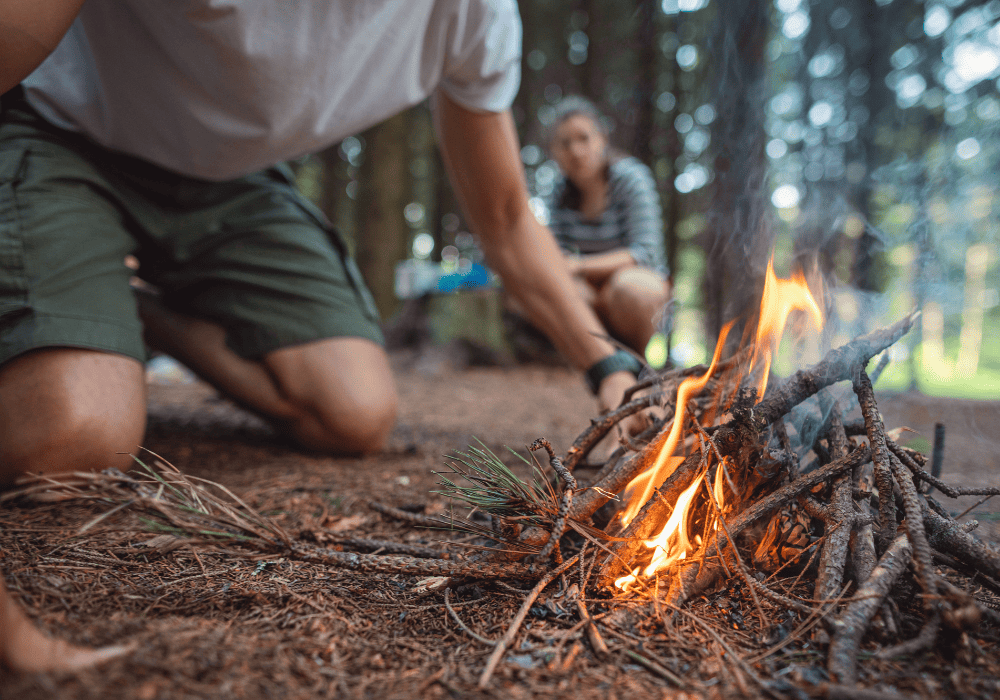
Mastery of these skills provides a critical advantage when contending with the unpredictability of the wilderness. Expertise in orienteering and navigation is equally vital, enabling individuals to traverse challenging terrain with confidence and direction.
Fundamental to surviving adverse circumstances is the ability to secure sustenance. Knowledge in identifying edible flora and effective methods of hunting or fishing is instrumental.
Understanding these survival techniques contributes to maintaining strength and health, which are paramount when faced with extended periods of duress.
These competencies, when honed, can markedly increase the likelihood of enduring and ultimately overcoming the extremities of nature.
Securing Shelter and Warmth
In survival situations, obtaining adequate shelter is paramount to protection against the elements.
Such shelters must shield you from wind, rain, and extreme temperatures, preserving your core body heat. The location of a shelter is as critical as its construction, with an emphasis on avoiding natural hazards and minimizing energy expenditure.

A well-constructed shelter can be made from natural materials available in the environment, such as branches, leaves, and snow. Understanding the principles of insulation and ventilation is essential to maintain warmth without succumbing to the dangers of a poorly ventilated space, such as carbon monoxide poisoning from a fire.
Creating insulative bedding is just as important as the shelter itself. Using materials like pine needles, leaves, or grass can create a barrier from the cold ground. In cold environments, it’s crucial to elevate yourself to minimize heat loss, an effect known as conduction.
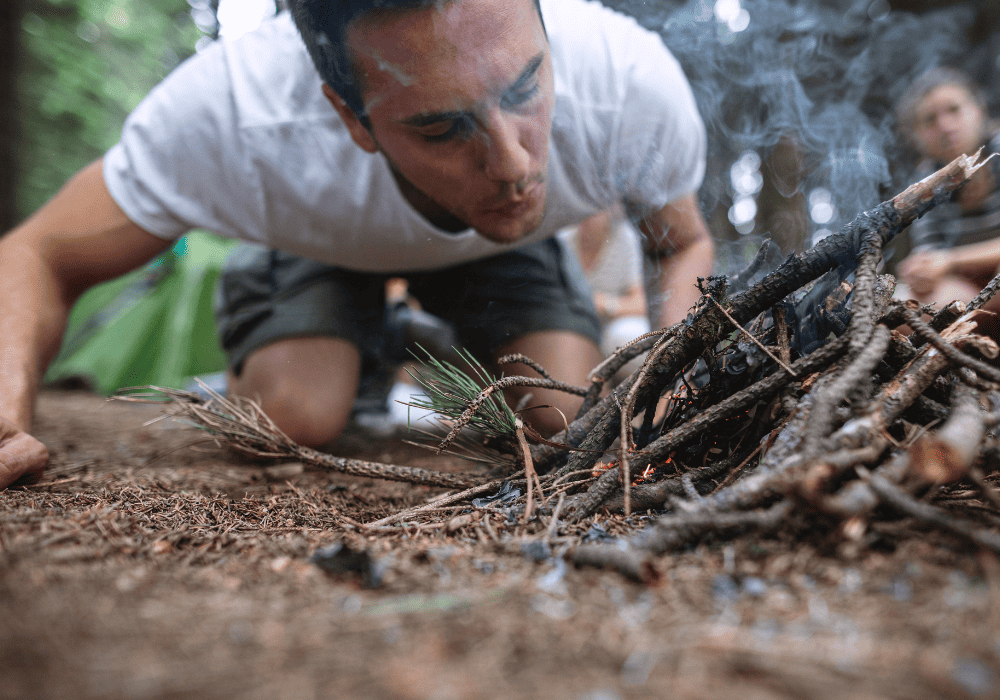
Remember the critical role of fire in both warmth and morale. Safely building and maintaining a fire requires not only skill but also a knowledge of the local resources.
The necessity to sustain a flame using available fuel sources can dictate the viability of your shelter location.
Investing time and energy into crafting quality shelter can make the crucial difference when harsh weather strikes. With shelter secured, your chances of survival increase significantly, allowing you to focus on other essential survival tasks.
Finding Water and Food Sources
Securing a reliable water source is paramount in survival situations; dehydration can incapacitate even the most resilient individuals. To sustain life, one must prioritize locating, collecting, and purifying water.

Survey your surroundings for natural water collections like rivers, streams, or lakes. Remember that water from these sources requires purification.
In environments where water is scarce, knowledge of landscape features that can indicate the presence of water—like the presence of green vegetation or the direction animals move in at certain times of the day—is imperative.
Techniques such as digging for water in dry riverbeds or collecting dew with cloth can be life-saving.
When searching for food, focus on readily available and energy-efficient resources. Edible plants, insects, and small game can be abundant; however, it’s essential to possess knowledge of local flora and fauna to avoid poisonous varieties.
As with water, understanding how to safely procure and prepare food is crucial—it can mean the difference between sustenance and sickness. Remember, the guiding principle is “when in doubt, go without” to prevent consuming harmful substances.
Preparing Survival Kits
A well-constructed survival kit is an invaluable asset in unforeseen circumstances, ensuring a higher degree of preparedness and security.
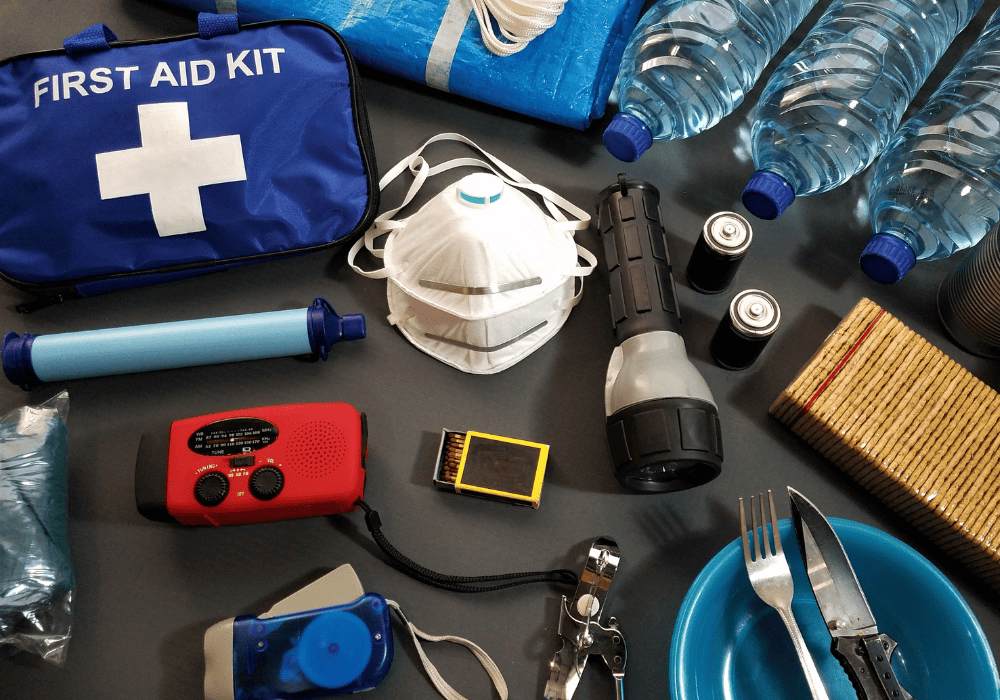
Including varied items like tools for fire-making and signaling, as well as navigation aids such as compasses and maps, broadens your ability to manage diverse challenges.
Also vital are first aid supplies, along with gear that can provide shelter from harsh elements.
Remember, the goal is to equip yourself with a kit that sustains basic needs and can help in self-rescue, should the need arise.
Essential Items for Your Pack
Select versatile and reliable equipment for your pack.
When preparing for outdoor adventures, it’s paramount to prioritize both the quality and utility of your gear. Your pack should include a multipurpose tool that can perform various functions, thereby maximizing its usefulness while minimizing carried weight.
Moreover, investing in a durable, lightweight shelter solution—such as a compact tarp or bivouac—is essential to ensure protection from the unpredictable elements.
Ensure you have a means to purify water.
Water purification methods are decisive in survival scenarios, making a portable water filter or purification tablets indispensable.
These resources must be proven effective against common pathogens to guarantee a safe drinking supply in the absence of potable sources.
Carry a comprehensive first-aid kit.
Alongside navigational aids, your survival arsenal must not lack first aid resources. A well-stocked first-aid kit that includes materials for dressing wounds, treating blisters, and addressing allergic reactions is indispensable.
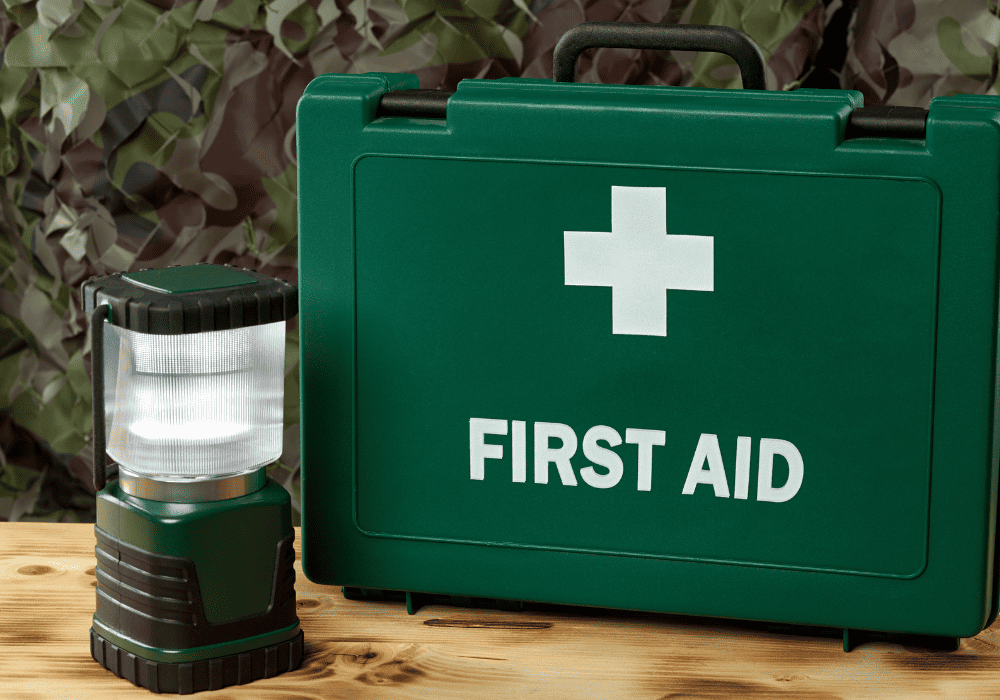
Consider customizing this kit to meet the specific risks of your intended environment and adventure.
Pack nutritional and long-shelf-life sustenance.
Lastly, it’s wise to include non-perishable, high-calorie food items that offer substantial energy with minimal preparation. Options like energy bars, nuts, and freeze-dried meals are excellent as they provide the sustenance needed without adding undue weight to your pack.
Plan meals according to your activity level and the duration of the excursion, ensuring caloric intake aligns with exertion levels for optimal performance.
Customizing Kits per Environment
In the realm of wilderness exploration, the concept of one-size-fits-all for survival kits is patently misguided. The constituents of your kit must be carefully selected based on the particular characteristics of the destination at hand.
An arctic trekker’s survival kit diverges markedly from that of a desert adventurer. Not only the thermal insulation materials, but also sun protection and hydration strategies differ.
Your preparedness for temperate forest settings might hinge on ample protection against ticks and mosquitoes carrying Lyme disease or West Nile virus. Conversely, high-altitude terrains necessitate gear that can help prevent altitude sickness and hypothermia.
Individualizing your survival kit is critical, as the essentials for a rainforest expedition – waterproof gear, water purification tablets, and anti-fungal treatments – would contrast sharply with the needs of a coastal environment.
There, items for signaling, fishing, and managing exposure to saltwater become preeminent. Regardless of the biome, adaptability is a lodestar in survival, propelling your readiness to match the idiosyncrasies of the landscape.
When it comes to surviving in the wilderness, being prepared with the right knowledge and equipment is essential. Here are some expert tips to help you customize your survival kit based on the environment you’ll be exploring:
- Arctic environments: For those venturing into the cold and icy landscapes of the Arctic, thermal insulation is crucial. Pack items such as insulated clothing, hand and foot warmers, and a high-quality sleeping bag rated for extreme temperatures. Additionally, include snow goggles, sunscreen, and a hydration system to protect yourself from the harsh sun and stay hydrated in the dry air.
- Desert environments: When facing the challenges of the desert, protecting yourself from intense heat and dehydration is paramount. Pack a wide-brimmed hat, lightweight and breathable clothing, and sunscreen with a high SPF. Ensure you have a sufficient supply of water, as well as electrolyte-replenishing tablets to prevent dehydration. It’s also advisable to include a compass and map, as well as a sturdy tent or tarp for shade and protection from sandstorms.
- Temperate forest environments: In temperate forest settings, it’s important to be prepared for encounters with ticks and mosquitoes carrying diseases. Pack insect repellent, tick removal tools, and appropriate clothing to minimize exposure. Additionally, include a map and compass for navigation, as well as gear to protect yourself from rain, such as a waterproof jacket and tent.
- High-altitude terrains: If you’re heading to high-altitude areas, be prepared for altitude sickness and hypothermia. Pack altitude sickness medication, warm clothing, and a sleeping bag designed for cold temperatures. It’s also important to include snowshoes or crampons for traction on icy surfaces. Pay attention to weather conditions and acclimatize gradually to prevent altitude-related health issues.
- Coastal environments: Excursions along coastal areas require specific gear for survival. Include items such as a signaling device, fishing equipment, and waterproof matches for fire-starting. Protection from the sun and saltwater exposure is crucial, so pack sunscreen, a hat with a chin strap, and a waterproof bag for your gear. It’s also wise to carry a life jacket or personal flotation device (PFD) in case of emergencies.
Remember, survival kits should always be personalized based on the environment you’re exploring. Adaptability and knowledge of the specific risks and challenges of each environment are key to ensuring your safety and preparedness.
When it comes to surviving in the wilderness, being prepared with the right knowledge and equipment is essential. Here are some expert tips to help you customize your survival kit based on the environment you’ll be exploring:
Arctic environments: For those venturing into the cold and icy landscapes of the Arctic, thermal insulation is crucial. Pack items such as insulated clothing, hand and foot warmers, and a high-quality sleeping bag rated for extreme temperatures. Additionally, include snow goggles, sunscreen, and a hydration system to protect yourself from the harsh sun and stay hydrated in the dry air.
Desert environments: When facing the challenges of the desert, protecting yourself from intense heat and dehydration is paramount. Pack a wide-brimmed hat, lightweight and breathable clothing, and sunscreen with a high SPF. Ensure you have a sufficient supply of water, as well as electrolyte-replenishing tablets to prevent dehydration. It’s also advisable to include a compass and map, as well as a sturdy tent or tarp for shade and protection from sandstorms.
Temperate forest environments: In temperate forest settings, it’s important to be prepared for encounters with ticks and mosquitoes carrying diseases. Pack insect repellent, tick removal tools, and appropriate clothing to minimize exposure. Additionally, include a map and compass for navigation, as well as gear to protect yourself from rain, such as a waterproof jacket and tent.
High-altitude terrains: If you’re heading to high-altitude areas, be prepared for altitude sickness and hypothermia. Pack altitude sickness medication, warm clothing, and a sleeping bag designed for cold temperatures. It’s also important to include snowshoes or crampons for traction on icy surfaces. Pay attention to weather conditions and acclimatize gradually to prevent altitude-related health issues.
Coastal environments: Excursions along coastal areas require specific gear for survival. Include items such as a signaling device, fishing equipment, and waterproof matches for fire-starting. Protection from the sun and saltwater exposure is crucial, so pack sunscreen, a hat with a chin strap, and a waterproof bag for your gear. It’s also wise to carry a life jacket or personal flotation device (PFD) in case of emergencies.
Remember, survival kits should always be personalized based on the environment you’re exploring. Adaptability and knowledge of the specific risks and challenges of each environment are key to ensuring your safety and preparedness. Jungle environments: Exploring the dense jungles requires specific precautions to stay safe.
When venturing into jungle terrain, it’s important to protect yourself from the abundant insect life and potential encounters with venomous snakes.
Pack insect repellent with a high concentration of DEET, a snakebite kit, and clothing that covers your entire body to minimize exposure. Equip yourself with a machete or sturdy knife for clearing vegetation, and include a compass or GPS device to navigate through the dense foliage.
Mountainous terrain: Ascending mountains can pose unique challenges and risks. Adequate preparation is essential to tackle steep slopes and unpredictable weather conditions.
Pack mountaineering boots with good ankle support, climbing harnesses, and ropes for technical sections. Carry a sturdy ice axe and crampons for glacier travel and ensure you have knowledge of how to use them.
In addition, include warm layers of clothing, a down-filled jacket, and a four-season tent designed to withstand high winds. Don’t forget to include a helmet for protection in case of rockfall, and carry extra food and water to sustain yourself during longer climbs.
Canyon environments: Navigating through rugged canyons requires specific gear for safety. Pack a sturdy backpack with essentials such as a first aid kit, headlamp, and multi-tool for emergency repairs.
It’s important to have proper footwear with good traction for scrambling on canyon walls. Include ropes and harnesses for rappelling and ascending steep sections.
Carry plenty of water, as canyons often lack a reliable water source, and pack high-energy snacks for sustained energy. Familiarize yourself with the routes and potential escape options before venturing into canyons to ensure a smooth and safe experience.
Remember, when exploring different environments, it’s crucial to have a thorough understanding of the specific risks and challenges associated with each location. Do your research, seek guidance from local experts, and tailor your survival kit accordingly to maximize your safety and preparedness.
What are the essential survival tactics for surviving in the wilderness?
Surviving in the wilderness requires a combination of knowledge, skills, and preparation. Here are some essential survival tactics to help you navigate the challenges of the great outdoors:
- Shelter Building: Knowing how to construct a shelter is crucial for protecting yourself from the elements. Look for natural features like rock formations or fallen trees, and use available materials to create a sturdy shelter that shields you from wind, rain, and cold.
- Fire Starting: Fire provides warmth, light, and a means of cooking food. Learn different fire-starting techniques such as using a flint and steel, friction methods like the bow drill or hand drill, or carrying waterproof matches or a reliable lighter.
- Water Sourcing: Finding clean water is essential for survival. Learn how to locate water sources such as rivers, streams, or natural springs. Use filtration methods like boiling, using water purification tablets, or portable water filters to ensure the water is safe to drink.
- Navigation Skills: Wilderness navigation skills are vital for finding your way and avoiding getting lost. Familiarize yourself with using a map and compass or navigation apps on your phone. Learn how to read signs in nature like the position of the sun and landmarks to maintain your bearings.
- Finding and Procuring Food: Understanding which plants are edible and how to identify game trails or signs can help you find sustenance in the wild. Learn about foraging, trapping, and fishing techniques, and carry a small survival kit with essential tools like snares, fishing line, and hooks.
- First Aid: Accidents can happen, so knowing basic first aid skills can be life-saving. Learn how to treat common wilderness injuries such as cuts, sprains, burns, and fractures. Carry a well-stocked first aid kit and know how to use its contents effectively.
- Emergency Signaling: If you find yourself in a dangerous situation, you may need to attract attention for rescue. Learn different methods of emergency signaling, such as using a whistle, mirror, or a signal fire. Carry a signaling device with you at all times.
Remember, the key to surviving in the wild is preparation and practice. Always inform someone of your outdoor plans and carry essential gear like a knife, a waterproof tarp, extra clothing, and ample food and water supplies. Stay calm, assess your situation, and use your knowledge and skills to stay safe until help arrives.
How can one stay mentally strong in a survival scenario?
In a survival scenario, staying mentally strong is crucial for making rational decisions, maintaining focus, and persevering through difficult situations. Here are some key strategies to help you stay mentally strong:
- Optimism – Maintaining a positive mindset can greatly impact your mental strength. Focus on the factors within your control and believe in your ability to overcome challenges.
- Emotional regulation – Emotions can run high during a survival situation. Learning to manage and regulate your emotions will help you stay calm and make rational decisions.
- Problem-solving – Break down complex problems into smaller, manageable tasks. Develop a systematic approach to address each challenge and stay focused on finding practical solutions.
- Adaptability – Survival situations are unpredictable, and the ability to adapt to changing circumstances is crucial. Embrace flexibility, adjust your plans as needed, and be open to new ideas or strategies.
- Self-care – Prioritize self-care to maintain mental strength. Get adequate rest, stay hydrated, and nourish your body with nutritious food. Avoid unnecessary stressors and take breaks to recharge when possible.
- Build a support system – Surround yourself with positive and supportive individuals who can provide encouragement and helpful insights. Sharing the challenges and successes with others can also boost your morale.
- Focus on small victories – Celebrate even the smallest achievements along the way. Recognizing your progress can keep you motivated and reinforce your mental strength.
- Mindfulness – Practice mindfulness techniques to stay present and focused on the current moment. This can help reduce anxiety and prevent negative thoughts from overwhelming your mind.
- Maintain a sense of purpose – Remind yourself of your ultimate goal and the reasons that drive you to survive. Having a clear sense of purpose can motivate you to stay mentally resilient in challenging times.
Remember, staying mentally strong in a survival scenario is a continuous effort. Regularly review and reinforce these strategies to build and maintain your mental resilience.

